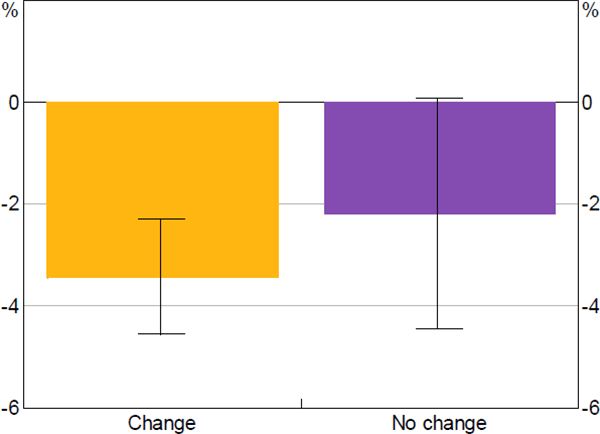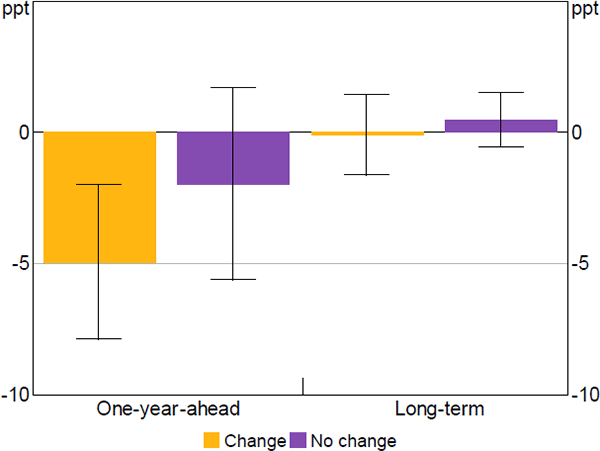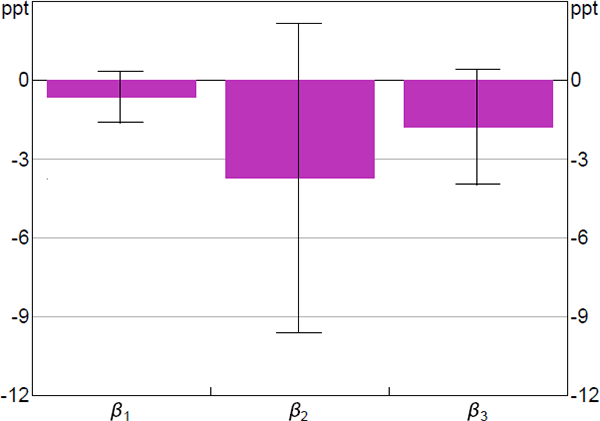RDP 2021-04: Monetary Policy, Equity Markets and the Information Effect 8. Robustness and Extensions
April 2021
- Download the Paper 1,551KB
8.1 Earnings across sectors
The response of the ASX 200 earnings growth forecasts to monetary policy surprises may not be representative of the effects of monetary policy across industries. The ASX 200 is heavily weighted towards the financial and materials sectors, which jointly account for around 45 per cent of the index, while other industries such as ‘information technology’ (IT) and ‘consumer discretionary’ account for only around 3 per cent and 6.5 per cent of the index. However, it is possible that the information effect could be observable in some industries but not others. For example, sectors more reliant on consumer spending could be more exposed to changes in monetary policy. To investigate the effect of monetary policy announcements across industries I perform the same analysis on earnings growth forecasts at the GICS sector level.
The results from these regressions are generally consistent with the aggregate ASX 200 earnings forecasts results: an unexpected tightening of monetary policy causes forecasters to revise down their earnings growth forecasts. However, many of the estimates suffer from low power and are not statistically significant.
The results reveal that one-year-ahead forecasted earnings of the materials, utilities and IT sectors are particularly sensitive to unexpected changes in monetary policy (Figure 10). The one-year-ahead earnings growth forecasts for the materials sector fall by 9.4 percentage points following a 100 basis point level increase in the OIS curve. Similarly, the IT sector's earnings forecasts fall by 6.9 percentage points, while the utilities sector earnings forecasts fall by 3.2 to the same increase in the OIS curve. One possible explanation for the relatively large estimates are that these sectors are particularly exposed to the exchange rate, which monetary policy is a key determinant of. Indeed, these sectors broadly correspond to the sectors most sensitive to the exchange rate found in Manalo, Perera and Rees (2015).

Note: Confidence intervals shown are 95 per cent and calculated using Newey-West standard errors
Sources: Author's calculations; RBA; Refinitiv; Thomson Reuters
The results also show that the one-year-ahead earnings forecasts in consumer-related sectors – consumer discretionary and consumer staples – are less sensitive to changes in monetary policy. The forecasted earnings revisions to monetary policy tightening in these industries are small, but still negative. Again, the exchange rate could be an important factor here, as these sectors could be less sensitive to the exchange rate and hence less exposed to changes in monetary policy.
Also, it is worth highlighting that the estimated one-year-ahead forecast revision is positive for only three sectors and in all these cases the estimates are statistically insignificant.
Similar to the findings for the overall ASX 200 earnings forecasts, the results for the ‘long-term’ forecast horizon are unclear (Figure 11). In general, the estimated effects of a surprise monetary tightening are small, and for all sectors the effects are statistically insignificant. Overall, I interpret these results as indicating that changes in monetary policy are unlikely to affect the long-term earnings growth of sectors.

Note: Confidence intervals shown are 95 per cent and calculated using Newey-West standard errors
Sources: Author's calculations; RBA; Refinitiv; Thomson Reuters
8.2 Removing the global financial crisis
One concern with the results is that the GFC could have a strong influence on the estimates. This is especially concerning as the largest monetary policy surprises occur during the GFC, which could make these observations highly influential. This issue is amplified as it is probable that any findings based on monetary policy surprises from the GFC are not externally valid as these surprises represent monetary policy responses to an extraordinary situation. For example, the RBA cut the cash rate by 1 percentage point on 3 separate occasions during the GFC (October 2008, December 2008 and February 2009). These represented the largest changes in the cash rate since the early 1990s. The unprecedented nature of the GFC make it (almost) impossible for market participants to have known the RBA's reaction function to these events. Therefore monetary policy surprises in this period may be more reflective of market participants updating their knowledge about the central bank reaction function to novel events or a particular set of data relative to other times. Another reason to be cautious about the inclusion of the GFC is that the abrupt nature of the GFC meant monetary policy became highly dependent on incoming news. If the monetary policy surprises during this period were correlated to incoming news (in the windows that I consider) this would violate assumption (2) and bias the results.
To address this issue, I remove the observations between September 2008 and April 2009 (inclusive) from the information effect regressions.[14] Over this period, the RBA cut the cash rate by 4.25 percentage points, with 3 percentage points being in 1 percentage point increments.
Figure 12 compares the response of the ASX 200 index to monetary policy surprises when using the full sample of monetary policy announcements, from Section 5.1, and when excluding the GFC period. The regression estimates are almost completely unaffected by the exclusion of the GFC period. The point estimates are similar and not statistically different from one another, indicating that the results are not contingent on variation during the GFC.

Note: Confidence intervals shown are 95 per cent and calculated using Newey-West standard errors
Sources: Author's calculations; RBA; Refinitiv
Similar results can be found when comparing the ASX 200 earnings revision estimates using the full sample and the truncated sample (Figure 13).The estimates between the sample periods are not statistical different from one another indicating that the GFC does not play a large role in the results.

Note: Confidence intervals shown are 95 per cent and calculated using Newey-West standard errors
Sources: Author's calculations; RBA; Refinitiv; Thomson Reuters
8.3 Surprise easing or tightening
The information effect regression (Equation (3)) is specified to be linear in the monetary policy surprises. Hence, monetary policy surprises in either direction are assumed to have the same effect on the dependent variable. However, it is possible that the effects of monetary policy are nonlinear; the responses to a monetary tightening could be different to a monetary easing (Florio 2004; Karras 2013). This could occur if, for example, agents weight the information content from monetary easing differently to monetary tightening. To examine this, I allow the coefficient on unexpected changes in monetary policy from Equation (3) to differ depending on whether the direction of the monetary policy surprise is positive or negative. Therefore, I estimate the following:
All variables are as they were in Equations (3) and (4), however now I [F1,t >0] is an indicator variable for when the monetary policy surprise (F1,t) is above zero, and I [F1,t 0] is an indicator variable for when it is less than or equal to zero. Hence, represents the estimated effect to a surprise monetary policy tightening, and for a surprise monetary policy easing. Both coefficients should be interpreted as the effect of a surprise increase in the OIS curve on the dependent variable.
For both the ASX 200 price index and one-year-ahead ASX 200 earnings growth forecasts the point estimates from a surprise monetary policy easing are larger (in absolute terms) than a surprise monetary policy tightening (Figures 14 and 15). However, the estimates are not statistically different from one another.
Similar to the baseline results, the estimated effect of monetary policy surprises on long-term ASX 200 earnings growth forecasts are statistically insignificant for both easing and tightening surprises. This similarly indicates that there is little evidence for asymmetries in monetary policy based on the direction of the monetary policy action.

Note: Confidence intervals shown are 95 per cent and calculated using Newey-West standard errors
Sources: Author's calculations; RBA; Refinitiv

Note: Confidence intervals shown are 95 per cent and calculated using Newey-West standard errors
Sources: Author's calculations; RBA; Refinitiv; Thomson Reuters
8.4 Cash rate change or no change
The measure of monetary policy surprises used is agnostic to whether any actual change in the cash rate occurs. That is, monetary policy surprises can occur in months where no change is made to the cash rate. Though this measure is theoretically sound, it is possible that monetary policy surprises that occur when the cash rate is changed could have a different effect on equity markets relative to monetary policy surprises when there is no change in the cash rate. One way this could occur is if agents perceive monetary policy surprises accompanied with an actual change to the cash rate as more salient changes in information. In this example, we would expect smaller (or possibly positive) equity market effects from surprise monetary policy tightening that are coupled with a cash rate change.
To examine this I re-run the information effect regressions by allowing the coefficient to vary depending on if there was an announced change in the cash rate target. That is, I estimate the following:
All variables are as they were in Equations (3) and (4), however now is an indicator variable for when the cash rate target was changed, and is an indicator variable for there was no announced changed in the cash rate. Hence, represents the estimated effect to a monetary policy surprise when the cash rate target was also changed, and for when there was no accompanying cash rate change.
For the ASX 200 index, the estimates suggest contractionary monetary policy drives a decline in equity prices regardless of if an actual change in the cash rate occurs (Figure 16). However, the estimated effect of monetary policy surprises when a change in the cash rate occurs is around 1.6 times larger than the estimate for when there is no cash rate change. But the overlap in the confidence intervals shows that the difference is not statistically distinguishable.

Note: Confidence intervals shown are 95 per cent and calculated using Newey-West standard errors
Sources: Author's calculations; RBA; Refinitiv
The results for the one-year-ahead forecasts are similar to the ASX 200 index (Figure 17). Both estimates show that one-year-ahead forecasts are revised down in response to contractionary monetary policy surprises. But monetary policy surprises accompanied with a cash rate change are estimated to have a larger response, with a 100 basis point monetary tightening driving a 4.96 percentage point decline in earnings forecasts, compared to a 1.98 decline when there is no change in the cash rate. However, similar to before, this difference is not statistically significant, indicating that the difference in estimates should be interpreted with caution. Lastly, consistent with the baseline results, the long-term earnings growth forecast estimates are small and statistically insignificant regardless of if there is an actual change in the cash rate or not.

Note: Confidence intervals shown are 95 per cent and calculated using Newey-West standard errors
Sources: Author's calculations; RBA; Refinitiv; Thomson Reuters
Overall, I find some differences in the sensitivity of equity prices and one-year-ahead earnings forecasts based on if the monetary policy surprise is accompanied by an actual change in the cash rate or not; with the effects of monetary policy surprises occurring with a cash rate change displaying larger absolute estimated effects. This could indicate that there may be an additional effect when there are changes in the cash rate – possibly because of the increased salience that cash rate changes generate. Nonetheless, it is difficult to come to a definitive conclusion as the estimated coefficients are not statistically different from one another.
8.5 Parameter stability
The information content of monetary policy announcements has changed substantially over time. Prior to December 2007, monetary policy board decisions were only accompanied with a statement if there was a change in the cash rate target. Since then, every board meeting decision has been accompanied by a statement. More recently, the use of forward guidance has become more common. Taken together, these developments in the RBA's communication could result in information effects being more prominent in certain sub-samples of the data. If true, this would result in the baseline specification (Equation (3)), which is predicated on parameter stability, to be misspecified.
To explore this possibility I conduct the Bai-Perron structural break test on the coefficient from Equation (3) for both the ASX 200 and ASX 200 earnings growth forecasts (Bai and Perron 2003).
I find evidence of 2 structural breaks between the relationship of the one-year-ahead earnings growth forecasts and monetary policy, occurring in February 2009 and June 2010. The timing of these breaks are around the GFC, potentially indicating that the structural break test could simply be identifying this unique period where there were large changes in information flow, which in turn could affect the information effect regression. Notwithstanding this, to account for these structural breaks I add dummy interaction terms to Equation (3) corresponding to the break dates. That is I estimate:
The regressions results are presented in Figure 18. The coefficients for both breaks are more negative than the baseline period, indicating that the effect of monetary tightening has become even more negative over time. This runs against the idea that the information effect has become stronger over time. However, the results could possibly indicate that there have been different drivers behind the monetary policy surprises over different samples. But it is difficult to draw any conclusions from the results as all coefficients are statistically insignificant, suggesting that the evidence for breakpoints is weak.

Note: Confidence intervals shown are 95 per cent and calculated using Newey-West standard errors
Sources: Author's calculations; RBA; Refinitiv; Thomson Reuters
Looking at the other structural break tests, I find no evidence of structural breaks in the response of the ASX 200 index and long-term earnings growth forecasts to the monetary policy surprises. Taken together, I find only weak evidence that parameter stability is an issue in the estimation of Equation (3).
Footnote
I do not recalculate the factors as this would change the factor loadings and the monetary policy surprises used. This would ultimately make the results not comparable to the baseline results. [14]